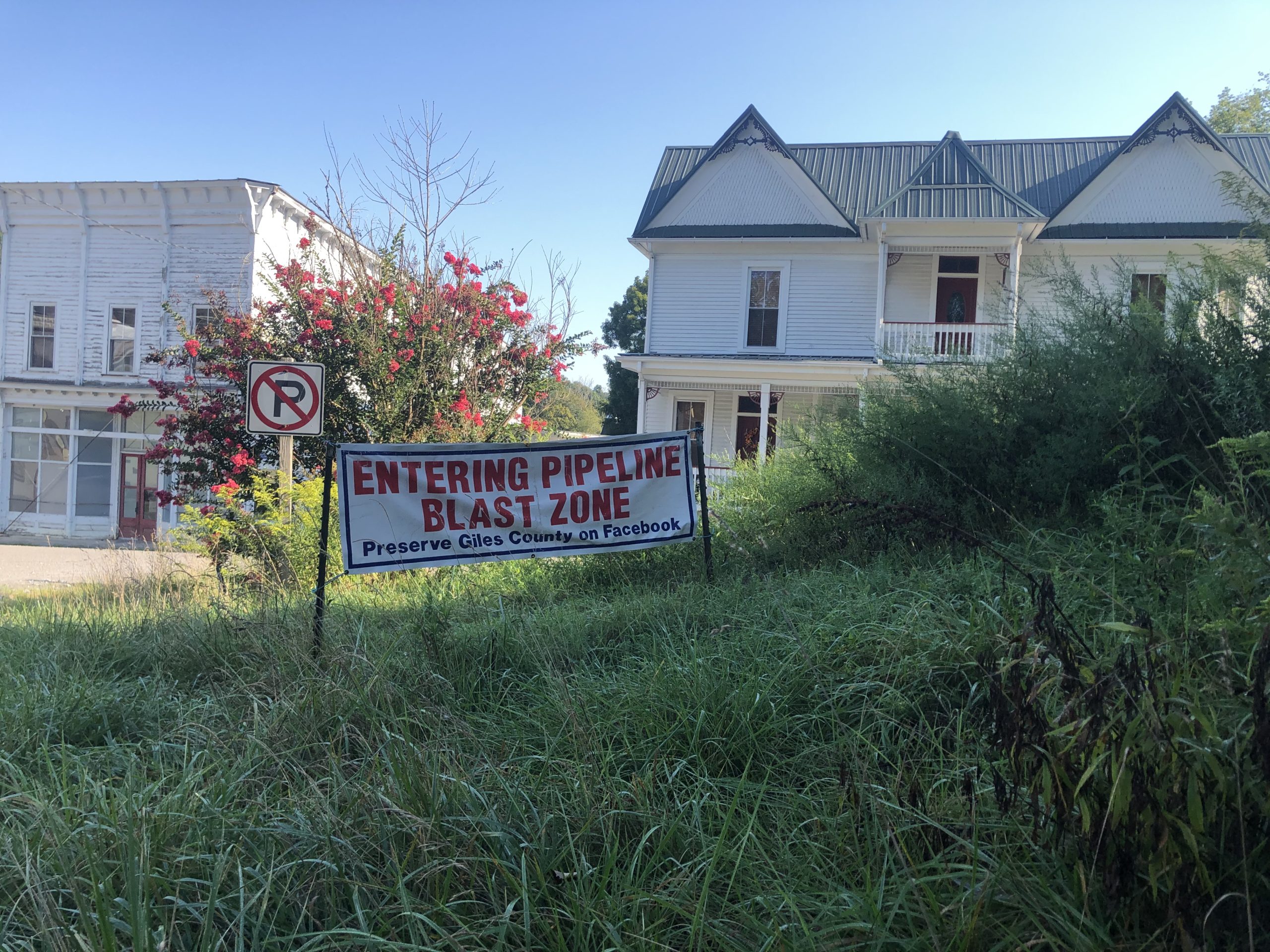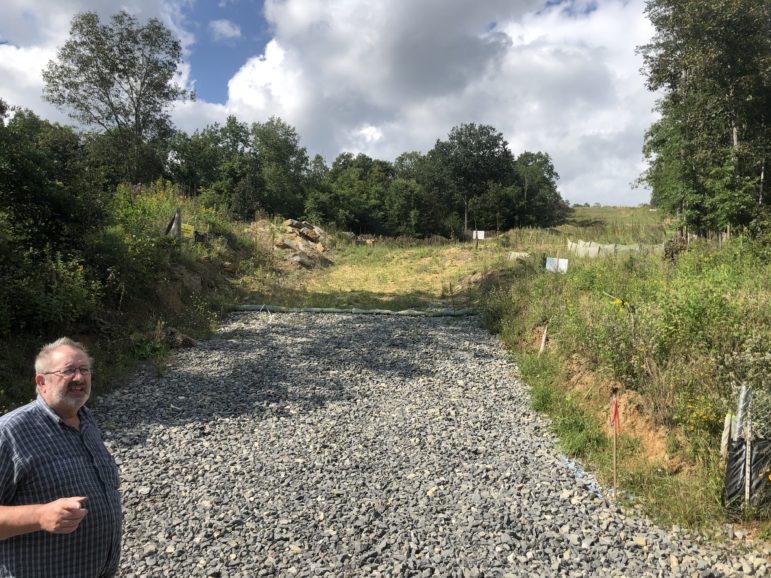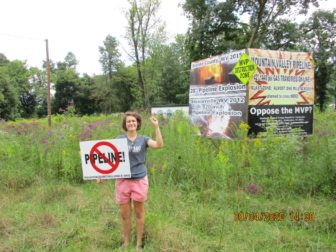
Through a Newcomer’s Eyes: Grounding Myself in People and Place Along the Mountain Valley Pipeline Route
- Posted on
- By Denise Robbins
- In Blog, Uncategorized
Maury called me throughout the whole drive over.
It was welcomed, as I trekked my way through the mountains and into Monroe County, West Virginia. He told me where to stop for cheap gas, which snacks I should grab, and the turns I would take down gravel roads to get to Sweet Springs. I knew nothing of the area. I had only just moved from New York to Richmond three weeks earlier — my car was still heavy from the last of my things.
I was there to tour the route of the Mountain Valley Pipeline. Told that my new position with CCAN would include fighting the Mountain Valley Pipeline, I knew I had to get a handle on the project and get in touch with the local resistance fighters. I had spent the week prior preparing myself, planning the logistics and buying supplies. But I was overwhelmed with what I actually witnessed. The contrast between the kind, caring folks I met and the sheer negligence of a company hell-bent on delivering unneeded fracked gas through farms, backyards, and public land was dizzying.

I arrived at Sweet Springs Resort, currently non-functioning but with a deep history. Maury Johnson acted as my tour guide these first few days. An expert in the area, he has filed over 180 violations (of sediment and erosion control, incorrect storage, among others) caused by the pipeline he has personally identified along the route. He explained that Sweet Springs Resort, named for the hot springs nearby, was a hotel for a period of time and the current property owner planned to restore it. When I inquired further into the past, he said that this spring originally belonged to native peoples (mostly likely historical Eastern Sioux lands of the Yesa Confederacy, but he never specified), and that there had been a massacre to acquire the land. This was an orienting way to start my trip: the aggressive reminder that we are all on stolen land. As I interacted with those whose properties were taken through eminent domain to build the pipeline, I remembered the long history of abuse and land theft.
Before we began our destruction tour, Maury pointed out three different water bottling plants and a few other springs resorts, touting that Peters Mountain has some of the best water in the world. Water is not just an attraction, but a source of manufacturing and a major economic driver. The pipeline’s presence threatens that. We first must consider the runoff, erosion and sediment deposited in this karst zone (meaning that there are underwater rivers and caves throughout the region) from construction alone. And keep in mind that with every project there is a possibility of leakage, which would poison the water in the whole region. This is not just folks’ drinking water and health we’re talking about (which should be reason enough to halt the project), but their livelihoods.
We drove in our separate SUVs, communicating by walkie talkie because of COVID concerns and its rising rates in the county. Maury stopped in the middle of the road to take a picture of a box turtle (they’re doing a study, he informed me) and safely delivered it to the other side. I can think of no better way to describe the folks in this fight — attentive and driven to preserve life. As we pulled up to the right-of-way at Pence Springs, my heart sunk. Lush green hills were stripped down to a 125-foot clearing. Along the edges of the stream were splitweed and ironweed, yellows and purples dotting the water before it opened up to a massive treeless zone. Here the pipe had already been put in the ground. It hasn’t held any gas and never will, if we have anything to do with it.
Other areas I came across were not nearly as “finished.” While MVP claims that they are 92% done, I cannot say I saw even half of that during my time. At only a few locations did I see the yellow topped markers indicating that the pipe was in the ground. Most of the route was vast dead zones. In the most “completed” areas, pipe was welded and staged with no trench to be seen. In other areas, the pipe wasn’t even staged — segmented and piled, left out to bake in the sun for years since they were placed there. These pipes and their coating aren’t supposed to sit out for more than one year, but I saw some dated 2017.
In other areas, it seemed utterly uncleared. Because of the stop work orders in place (status uncertain due to the recent biological opinion), several sections in Giles County had time to regrow for the past two years. Nature is resilient; the ecosystem in these areas will restore itself. As long as we stop gas from ever entering these pipes, there is a chance to bring these areas back.
During my time on the route, I was able to visit the Yellow Finch Tree Sit as they marked their two-year anniversary. The right-of-way here looked particularly rotten — horrible, steep, brown, with big white tarps over it — a band-aid to control MVP’s numerous erosion violations. It looked like a black diamond ski slope with its steep drop-offs, but far wider than any expert run would be. I hiked up a logging road, imagining what a terrible sight it must have been for those at camp as thousands of trees like the ones they were sitting in were trucked out. With a wave of death snaking through the hills in one direction, the other view held a hand-felled cut, leading right up to a remaining stand of trees on the route. From this height, I could see a little bit of white amidst the canopy — a poster draped over one of the sits. As gut-wrenching as it was to see all of that barren land, this little section imbued some much-needed hope in me. I hiked down to get a look at the sits from below.
There were three platforms about fifty feet up in the trees. They had buckets and pulley systems, banners and tarps. Beneath them were big umbrella-like barriers to prevent anyone from climbing up. MVP had only sent one surveyor who had climbed once – to spike a tree, killing it, where a sitter’s platform was staged. These folks are willing to put their bodies on the line and break the law for what they know is right. It reminded me of other fights against injustice, and the presumed “illegality” of human bodies when they are in certain spaces. Social justice and environmental justice are joined in so many ways — like how climate refugees will only increase with extreme weather.
Anniversary day was a weird one – celebratory for the staying power of the Yellow Finch tree-sitters — but deeply tired. Yellow Finch hasn’t had many visitors other than stalwart suppliers due to COVID-19, but last weekend about ten of us visitors sat apart from each other in the dirt, trying to make the most of it. Folks walked around drinking beer and eating cakes with antifascist slogans. While morale was high that day, there was the explicit hope that we all wouldn’t be there next year. These tree-sitters want to go home, to not have to face another winter out here in the cold. In full organizer mode, I asked what I could do to help – did they need material resources, what sorts of media should I send their way, etc. At one point, I received a blank stare: “Just stop the pipeline.” It was a sobering moment. The tree sits are a stalling method for the tedious legal, policy, and media work – for those of us who are down here safely on land to do our jobs and stop this pipeline from ever being completed. We all have our place in this fight; we too have a vital part to play.
My trip was coming to a close around Labor Day, which I spent with Russell Chisholm, the leader of a coalition of local “preserve” groups called POWHR. I drove into the Newport Village Green to meet him, welcomed by a sign stating “You are now entering the blast zone.” Unlike my experiences with Maury, we didn’t visit the private landowners affected, but instead travelled along the Forest Service land that had been permitted for construction. The thought of this alone is unsettling — a forest that is supposed to serve the public good and is highly frequented by campers is now zoned to have a massive 42-in pipeline running through it. Forty-two inches is a huge diameter: I stood next to these wide tunnels, and realized I could easily crawl inside.
We approached the right-of-way through the Jefferson National Forest, a steep path that included several hard right angles. As we pulled in, we saw that posted up on a tree were notices that this area — of public land — was off-limits due to construction. To circumvent our inability to walk the site, Russell brought out a drone — a very helpful tool in catching when and where construction begins again. That day it showed me a longer stretch than I could imagine — a trail of brown bobbing over ridges through the otherwise verdant forest. The aerial view from the drone showed me the magnitude of this project — of how much has gone to waste when the MVP is cancelled like the long-fought Atlantic Coast Pipeline.
There are countless other horror stories I could share: of retirement dream homes built from scratch t on old family property that was completely bisected by the pipeline; of flower beds outside kitchen windows torn up for an easement less than 100 feet away; of a sinkhole caused by boring into CARST zones near a couple’s chicken coops; of an organic farm that will disappear if the pipe is filled with gas. I have the happier stories, as well: of posters, walls and cars painted in anti-pipeline slogans; the jokes and onion rings among the trees; the fresh country eggs that were gifted to me for breakfast; the folks that opened their homes and their hearts to me as I slept in their backyards.
I drove the three hours back to Richmond meditating on what I had seen. Resolved and directed, I am acutely aware of my place in the fight. You too have a place.
The fight’s not over. September 11 is the FINAL DAY to submit comments to FERC to oppose the extension to the MVP. The deadline to file a comment is 5pm this evening. You can sign the CCAN public comment here or file a personal comment of your own through FERC with this toolkit.
Please also donate to Appalachians Against Pipelines in support of the Yellow Finch Tree Sit, POWHR or CCAN. We will always be outspent by MVP — only we can fund our collective liberation.

